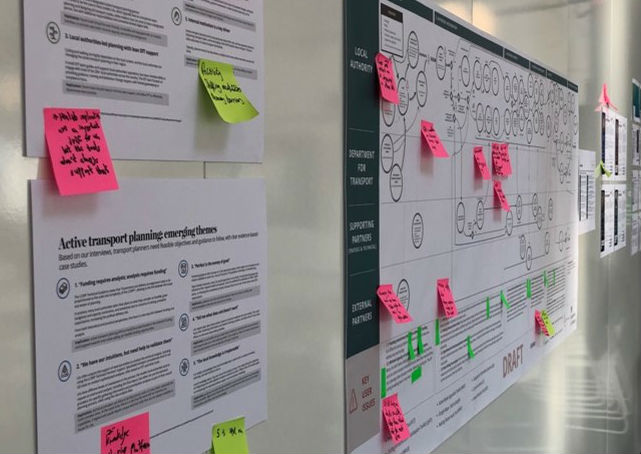
Discovery is an important phase of many government digitisation projects. It focuses primarily on establishing user need for the service and finding out what already exists that might meet that need. This prevents unnecessary spend, and makes sure that money is spent on features that users need, rather than on the bells and whistles.
DfT’s Digital Service is now looking to broaden discovery in the project phase, with more speculative discussion focusing on delivering better outcomes for the future and not just better versions of today. We’re calling this Discovery 2.0.
Discovery 1.0 - better versions of today
- start with a defined problem
- a stage of a project
- needs users to have been born
- templated methodology
- looking to test assumptions
- observation of the current situation
Discovery 2.0 - better outcomes for the future
- speculative, ongoing agenda
- unknown unknowns
- users might not have been born
- look at anticipated change consequences
- dynamic methods and techniques
- forms and develops assumptions
- comfortable with ambiguity
We believe there is value in this approach, but it means making a change in the organisation so we’re starting to light little fires where there is the opportunity to do so and the first of those is now alight.
Planning tools for active travel
One of the best ways to innovate is to work with external experts, and so using the Digital Marketplace, a contract was awarded to Deloitte to work with the DfT and explore the broad topic of active transport planning.
Dave Tansley, Deloitte Engagement Partner, explains the team’s approach:
The project set by DfT’s Cycling & Walking unit was to analyse how digital tools can be used to provide the best infrastructure for the needs of cyclists and pedestrians across the country, while optimising the government’s £1 billion active transport investment.
DfT has already developed pilot tools that are widely used by transport planners to plan active transport infrastructure, including the fully operational Propensity to Cycle Tool (PCT). However, from the outset it was made clear that the Deloitte’s work should not be constrained by existing pilot tools.
Instead, we set out to identify the issues pedestrians and cyclists were facing when getting from A to B, evaluating new technology and data sources that could enhance the planning outcomes for their benefit. As a result, we were able to conduct a thorough analysis which concentrated on the needs of the local transport authorities and the cyclists and pedestrians themselves.

Our analysis was supported by research collected from online surveys and interviews with over 20 local authorities and industry stakeholders. You can watch a recording of one of our industry workshops on YouTube.
We also conducted a thorough technical assessment, evaluating the existing pilot tools against the needs of the transport planners. Additionally, we looked at future technology options, assessing how DfT could engage with technology providers and data suppliers to improve their planning systems.
Our analysis highlighted that some key steps in the process are not yet supported by digital tools, and some improvements can be delivered through rather simple solutions, such as incorporating additional publicly-available data sources into the existing tools.
The analysis also found that while the pilot tools were successful, there is a need to provide more robust and reliable tools for planners, for example by improving the quality of the underlying data and exploring opportunities to integrate new apps and mobile data sources.
What is the value of this approach?
Truly focusing on the users. By not being constrained by existing processes or tools, we can concentrate on the needs of transport planners. This approach led to a few insights:
- some ‘quick-win’ improvements, such as sharing knowledge regarding the impact of previous infrastructure changes, can add significant value
- providing new tools can only add limited value if planners don’t have the capacity, training, or support to use them
- if the underlying data is unreliable, no analysis will be trustworthy
By conducting a more speculative analysis guided by our initial hypotheses, we could address the full user journey, and not just solve the problems experienced with existing tools.
Keeping up with the rapidly changing transport domain
As part of our exploratory analysis, it became clear that there are new opportunities in the market. Cycle-sharing schemes and dockless bikes can provide an additional source of reliable, timely data.
Commuters are looking for new ways to move across cities and, by providing the right infrastructure, we can encourage people to take different types of transport or different routes to reduce congestion. New data sources, including mobile apps, can support planners in analysing aggregated and anonymised transport routes.
The transport sector is changing rapidly, and this Discovery framework can support DfT in providing the right tools and policy support to take advantage of new digital opportunities and mitigate emerging challenges.
Digital tools as a business driver
Digital tools can allow DfT to unlock new value-adding opportunities. For example:
- New data sources, such as air quality indices, have the potential to unlock new funding opportunities for local authorities.
- Introducing simpler tools can make it easier for analysis to be undertaken in infrastructure projects, allowing even small-scale projects to be underpinned by robust data.
- Improved analysis capabilities can inform complex consultation, for instance supporting planners in challenging any scepticism towards the introduction of new bike lanes.
Using this more speculative approach, digital tools can be used as a key business driver, rather than simply a supportive enabler.
To conclude, Deloitte was delighted to support DfT in their efforts to understand how the use of digital tools could be enhanced to improve cycling and walking infrastructure throughout the country, and we hope to continue to work together, in order to shape the future of mobility.
What’s next?
This piece of work pushed the boundary of what discovery has previously been understood to be, but we know we can go further, starting by looking at the context of the service before we focus on what it needs to be.
Being honest to the Discovery 2.0 approach is a hard thing to do when there is pressure to answer the “but what do we need to do now” question. But the value of the speculative approach was demonstrated in discussions with the team where the conversation wasn’t about which features to add to existing tools but what the opportunity was to deliver greater value for money from investment in active travel schemes.
Our Digital Business Partners are working across the department to stimulate, surface and shape demand for digital. Promoting this approach will be a key activity for them and we hope they continue to demonstrate the value by taking small steps.